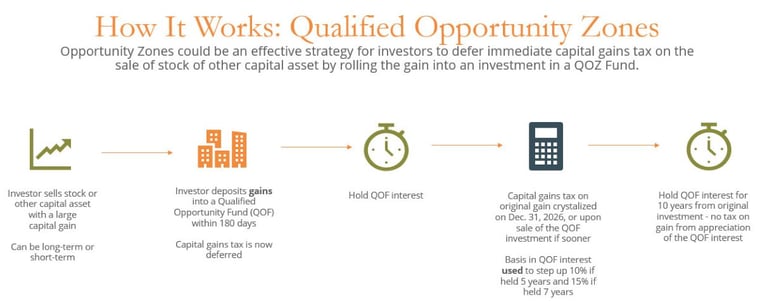Time to Zone In on the Tax Benefits of Qualified Opportunity Zones (QOZ)
How to Zone In on the QOZ Tax Benefits
With the unprecedented decade-long run in US stocks and real estate, prices look to be returning to more normalized growth rates. We are now seeing increasing numbers of clients choosing to ring the register and cash in at least some of those monster gains. But what about the taxman? He will want his cut of those gains. Here we examine an increasingly popular way to reduce the tax take on those gains by re-investing them (or part thereof) in a Qualified Opportunity Zone.
The QOZ Basics
There are 5 major points to note about investing in a QOZ:
- You can use a QOZ to save taxes on gains arising from almost any capital asset – stocks, bonds, property, artwork, a business. The scope is broad, but the asset must be a capital asset – so it's not applicable to income such as wages or IRA distributions or lump-sum bonuses.
- The gains can be long-term or short-term. It is not widely known that short-term gains are eligible gains for a QOZ investment. This could be particularly beneficial because short-term gains are taxed at the higher ordinary income tax rates - as opposed to the lower rate for long-term gains.
- The gain must be re-invested (rolled over) into the QOF within 180 days of the original realization and then must be claimed on your tax return for the year of the gain.
- You can choose how much of the gain you wish to re-invest into the QOZ – you are not required to re-invest the entire gain but that portion of the gain which is not re-invested would be taxable.
- The requirement is to re-invest the “taxable gain.” It is usually, but not always, a much lesser number than the proceeds received – so it is possible to save on taxes and still access a significant portion of the proceeds from a liquidity perspective. See below for the Amazon example.
The Tax Benefits of a QOZ
There are two major tax benefits that come with a QOZ investment, the Deferral and the Exemption.
- Deferral. Taxes on a current year capital gain (“the original gain”) are not payable until April 15th, 2027. This gives you plenty of time to put those saved taxes to work for you and indeed to plan to reduce the payment when it becomes due. See Planning for the 2027 Tax Payment.
- Exemption. The amount re-invested in the QOZ itself can be realized tax-free if held for 10 years. There are no guarantees how the QOZ investment will perform, but if there are gains, they will be free of tax.
Let’s look at an example of how a QOZ can save you very significant sums on your taxes.

QOZ Example – Selling Your Amazon
Let's assume you sell your Amazon shares for $1M in 2022 – you paid $400K for the shares back in 2019 so you have a long-term capital gain of $600K in 2022. Your tax rate on this gain is likely to be 20%, the top long-term capital gains rate, plus an additional 3.8% Net Investment Income Tax plus state tax (which can add another 5-13% depending on your state of residence). Let us assume an effective tax rate of 33% on the gain – that would mean a $200K tax bill for the year.
Now if you were to re-invest that gain of $600K in a QOZ you would not have to pay the $200K tax on the original gain until April 15th, 2027 – the Deferral. If you hold the QOZ investment for 10 years and it doubles in value over that time, you will not owe any tax at all on that QOZ gain – the Exemption.Planning for the 2027 Deferred Tax Payment
We do not recommend selling your QOZ investment to pay the original tax bill that crystalizes in 2027 – that is because if you sell the QOZ investment before the 10-year holding period, any gain would be taxable. Instead, we recommend an Active Tax Loss Harvesting Strategy be deployed to generate capital losses in the meantime which can be used to off-set the gain crystalizing in 2027. Additionally, the $200K can be invested until 2027 – growing at a little over 8% per year, the $200K would make you about $100K in that time, effectively cutting your 2027 deferred tax bill in half.
Considerations for a QOZ Investment
- Most investments in a QOZ are done by investing in a QOZ Fund – these Funds function similar to a mutual fund or REIT investment – BakerAvenue have performed due diligence on a number of these QOZ Funds and will work with you in selecting an appropriate Fund for your needs.
- Most QOZ Funds pay income in the form of distributions after an initial stabilization period – this can significantly boost the overall return on the investment.
QOZ investments tend to be non-correlated with, and diversified away from, high growth equities. - QOZ investments are illiquid – funds will have exit restrictions particularly in the earlier years – investors should view these as 10- year investments.
- Most QOZ funds charge Fees in the 1.5 - 2% range – several also charge performance fees once a hurdle rate of return has been achieved.
- Like any investment, QOZs can underperform.
Like any other investment every QOZ Fund needs to be evaluated and BakerAvenue is here to help you make the decision if a QOZ investment is right for you.
For more information on Qualifying Opportunity Zones, contact BakerAvenue to discuss how we can help you start to think about an estate plan or navigate the complexities of basis step-up.